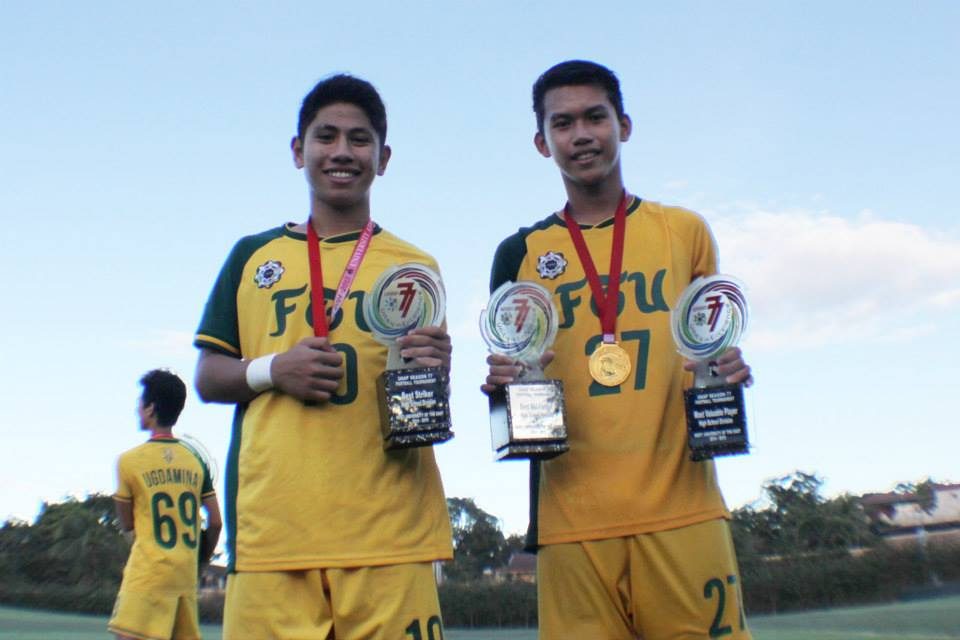SUMMARY
This is AI generated summarization, which may have errors. For context, always refer to the full article.

CEBU CITY, Philippines – Through the years, Cebuano football players have made their impact outside Cebu in collegiate leagues like the UAAP. Their presence has become more evident in recent football competitions.
In the just concluded UAAP men’s football competition which the Ateneo Blue Eagles won via a 1-0 edging of the FEU Tamaraws in last weekend’s championship game, there were 12 players from Cebu playing for different university teams.
There’s Lawrence Colina, Eddie Alivio and Hayeson Pepito of the NU Bulldogs; Kintaro Miyagi of the UP Fighting Maroons; Mark Arranguez and Dominique Canonigo of the FEU Tamaraws; Enzo Ceniza, Jimmy Haosen and Marc Nacional of the Ateneo Blue Eagles; and Nico Villacin, Raphael de Guzman and Jeremiah Bernaldez of the DLSU Green Archers.
These players also play big roles in their respective teams. In fact, Ceniza, a rookie in this year’s 79th season, was named into the Mythical 11 alongside Jordan Jarvis, whose mother traces her roots to Cebu. Jarvis, who also plays for Ateneo, was also named Rookie of the Year, this season.
Before Ceniza and Jarvis, there were Canonigo, who was named MVP when FEU won their fifth straight juniors title in Season 77 and was twice the Best Midfielder, and Arranguez who was named Best Striker as well in Season 77.
Colina was also named into the Mythical 11 last season and was even in the running for this season’s Golden Boot award when he brought his score count to 6 goals alongside eventual Golden Boot awardee Javier Gayoso when he scored a hattrick in NU’s 3-0 blanking of DLSU. Colina, however, was sidelined by a knee injury and was ruled out of the season during the second round of the competition.
Colina and Canonigo said that when they first started playing for their respective teams in Manila, it took them awhile to adjust.
“At first oo, kay di bya mi pareho ug culture or environment nga ge gikanan but as time passes by naka adjust raman pud nuon,” Colina said.
(At first yes because we did not come from the same culture or environment but as time passes by, I was able to adjust.)
As for Canonigo, his problem was getting homesick. “Una ga lisod dre kay ma homesick pero mga after 2 weeks kay medyo nawala na.” (At first I had a hard time here because I got homesick but after two weeks, it eased a bit.)
Both boys said they never experienced being discriminated on the pitch despite being from the province.
“Nice kaayo. Respeto kaayo sila sa mga bag’o ila pud mi gi tudluan sa mga basic skills,” said Canonigo of how the other players treated him. (It was very nice. They respect the new ones and they also teach us the basic skills.)
Arranguez, for his part, however said that discrimination is something that will always be there but not in a major way. Instead of answering back, he says he’d rather let his game do the talking for him.
All 3 admitted that playing in the UAAP is more competitive than playing in the CESAFI, Cebu’s own version of the UAAP.
“Lahi ra jud siya sa UAAP because labanan kasi ng pride eh so dapat talaga naa jud kay pride. CESAFI man gud sauna kay murag wa lang, like oo duwa madaug mapildi murag okay lang, ana gani,” said Colina.
(It is really different from the UAAP because it is a battle of pride which means you have to have pride. In the CESAFI, it’s like it is nothing, like yes you play, you win, you lose, all is just fine, just like that.)
Perhaps spelling the difference between the two inter-school leagues is that before the UAAP season opening, UAAP school members hold a pep rally to introduce their teams in different sporting events in their respective universities and thus drum up pride and support for the teams when they finally see action in various competitions.
Arranguez said he wishes that the CESAFI football competition would follow that of the UAAP so it would get a wider recognition.
All 3 said they are very proud with the growing number of Cebuano football players making their presence felt in the UAAP.
“Oo, kay syempre makita sad nimo ang product sad sa mga coaches dre or sa grassroots dre Cebu dili kay puro kamaynilaan nalang tanan or taga asa ang mga player didto,” said Colina.
(Yes because we can also see the products of the coaches here or the grassroots here in Cebu and not just products of Manila or wherever the other players come from.)
As for other Cebuano players aspiring to also get to play in the UAAP, Colina has this advice: “Just don’t stop believin’, dreaming, reaching for your goals! Kay ako sad bitaw wa man sad gyud koy alamang ani nga didto gyud diay ko maka skwela.)
(Just don’t stop believin’, dreaming, reaching for your goals! Because even me, I had no idea that I’d be able to study there.)
Canonigo adds that they should be diligent in their training and always play their best because they’d never know if a recruiter is around and they would get noticed.
To which Arranguez adds “dapat every game buhaton ang best kay wala biya ta kabalo kanus-a naay mag scout dili ra para UAAP.” (They should do their best in every game because we’d never know whenever there is someone scouting not only for UAAP.) – Rappler.com
Add a comment
How does this make you feel?
There are no comments yet. Add your comment to start the conversation.